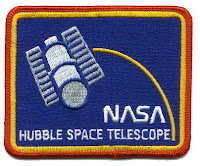NASA - Hubble Space Telescope patch.
Nov. 4, 2020
Sorry Charlie Brown, NASA's Hubble Space Telescope is taking a peek at what might best be described as the "Greater Pumpkin," that looks like a Halloween decoration tucked away in a patch of sky cluttered with stars. What looks like two glowing eyes and a crooked carved smile is a snapshot of the early stages of a collision between two galaxies. The entire view is nearly 109,000 light-years across, approximately the diameter of our Milky Way.
The overall pumpkin-ish color corresponds to the glow of aging red stars in two galaxies, cataloged as NGC 2292 and NGC 2293, which only have a hint of spiral structure. Yet the smile is bluish due to newborn star clusters, spread out like pearls on a necklace, along a newly forming dusty arm. The glowing eyes are concentrations of stars around a pair of supermassive black holes. The scattering of blue foreground stars makes the "pumpkin" look like it got all glittery for a Halloween party.
What's going on in this pumpkin-like pair?
Image above: This is a Hubble Space Telescope snapshot of the early stages of a collision between two galaxies that resembles a Halloween carved pumpkin. The "pumpkin's" glowing “eyes” are the bright, star-filled cores of each galaxy that contain supermassive black holes. An arm of newly forming stars give the imaginary pumpkin a wry smirk. The two galaxies, cataloged as NGC 2292 and NGC 2293, are located about 120 million light-years away in the constellation Canis Major. Image Credits: NASA, ESA, and W. Keel (University of Alabama).
If you mix two fried eggs together, you get something resembling scrambled eggs. The same goes for galaxy collisions throughout the universe. They lose their flattened spiral disk and the stars are scrambled into a football-shaped volume of space, forming an elliptical galaxy. But this interacting pair is a very rare example of what may turn out to result in a bigger fried egg—the construction of a giant spiral galaxy. It may depend on the specific trajectory the colliding galaxy pair is following. The encounter scenario must be rare because there's only a handful of other examples in the universe, say astronomers.
The ghostly arm making the "smile" may be just the beginning of the process of rebuilding a spiral galaxy, say researchers. The arm embraces both galaxies. It most likely formed when interstellar gas was compressed as the two galaxies began to merge. The higher density precipitates new star formation.
The dynamic duo hides out 120 million light-years away in the constellation Canis Major, so it is seen far behind the star-filled foreground plane of our Milky Way galaxy. Therefore, it's a difficult area to pinpoint far-flung distant background galaxies from the plethora of stars seen in the field.
Hubble Spots Giant Space ‘Pumpkin’
Video above: Halloween is scarier with Hubble! What looks like two glowing eyes and a crooked carved smile is a snapshot of the early stages of a collision between two galaxies. This new image is just one of several spooky views Hubble has captured in the universe. Video Credits: NASA's Goddard Space Flight Center.
The galaxy pair was similar to objects tagged by the citizen-science project Galaxy Zoo, where volunteers go hunting for oddball-looking galaxies. Astronomer William Keel, of the University of Alabama in Tuscaloosa, included several of these in the "Gems of the Galaxy Zoos" Hubble program, which is observing several kinds of rare galaxies during short gaps between other scheduled Hubble observations. The Hubble image brought out new details of the close encounter.
Hubble Space Telescope (HST). Animation Credits: NASA/ESA
Keel speculates that the ultimate destiny for this pair will be to merge into a giant luminous spiral galaxy like UGC 2885, Rubin's Galaxy, which is over twice the diameter of our Milky Way. Hubble has caught a snapshot of the groundbreaking early stages of a galactic makeover.
The Hubble Space Telescope is a project of international cooperation between NASA and ESA (European Space Agency). NASA's Goddard Space Flight Center in Greenbelt, Maryland, manages the telescope. The Space Telescope Science Institute (STScI) in Baltimore, Maryland, conducts Hubble science operations. STScI is operated for NASA by the Association of Universities for Research in Astronomy in Washington, D.C.
Hubble Space Telescope (HST): https://www.nasa.gov/mission_pages/hubble/main/index.html
Image (mentioned), Animation (mentioned), Video (mentioned), Text, Credits: NASA/Lynn Jenner/pace Telescope Science Institute/Ray Villard/University of Alabama/William Keel.
Best regards, Orbiter.ch



